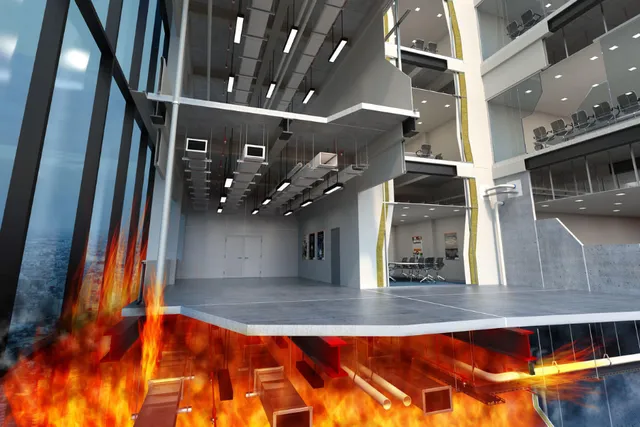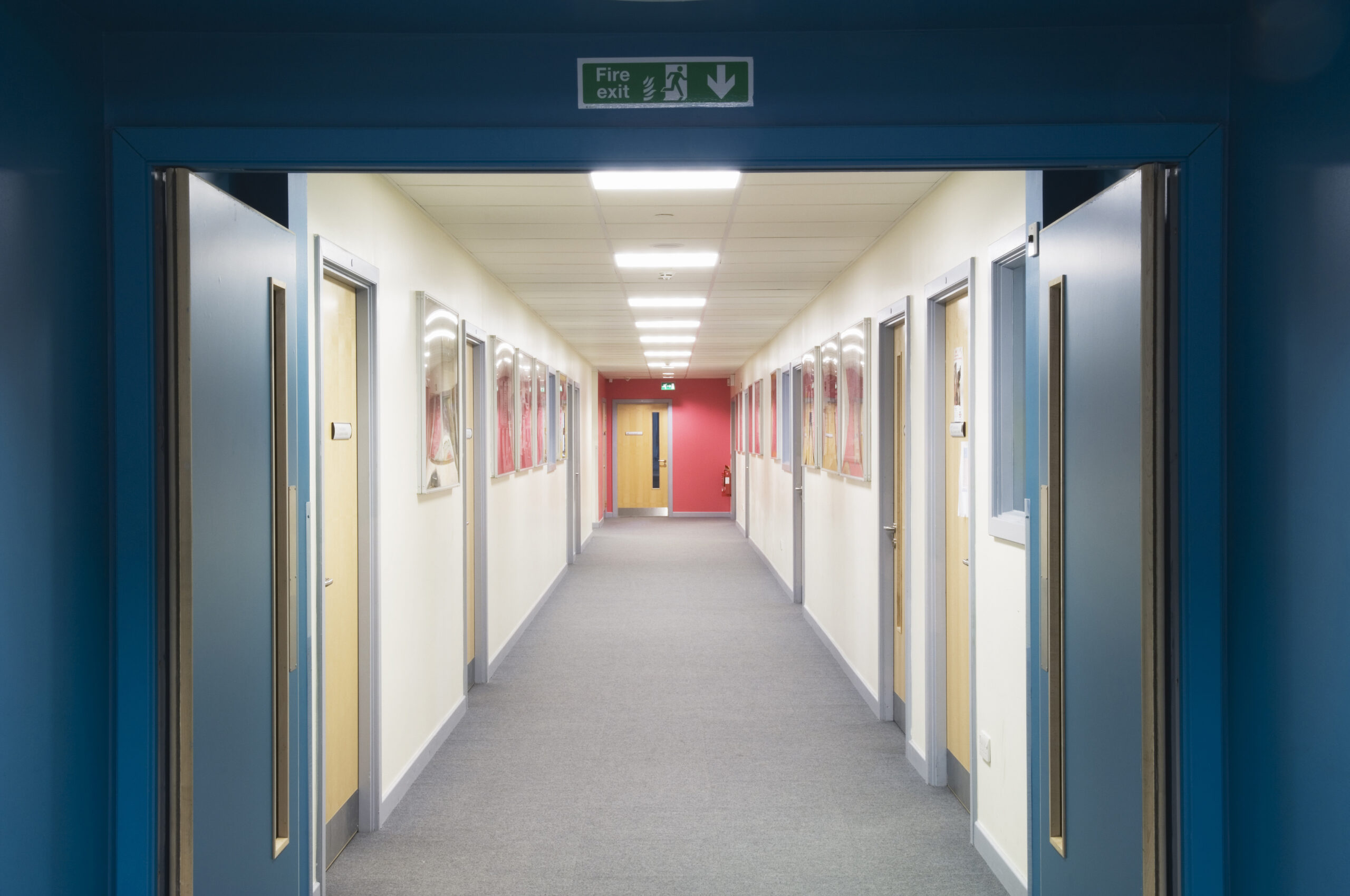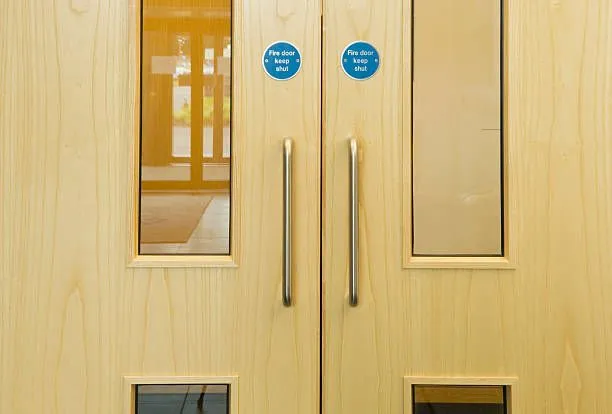
5-Star Passive Fire Protection
Fire Door Requirements & Regulations: A Fire Door Guide
Ensuring that properties are both equipped to effectively slow the spread of fires and legally compliant with the latest safety regulations is important for all properties. One major aspect of fire safety in buildings is properly fitted fire doors, which can help to contain fires for as long as possible. In this fire door guide, we’ll cover all of the core details that you need to know about – including requirements, regulations, maintenance and more.

What is a Fire Door?
So, what is a fire door? Fire doors are an integral component of a building’s passive fire protection system. These specialised doors are designed to prevent the spread of smoke, flames, and toxic gases in the event of a fire, allowing occupants to safely evacuate the building and enabling firefighters to control the blaze more effectively. Fire doors play an important role in safeguarding lives and property during emergencies.

What are Fire Doors Used for?
Understanding what fire doors are used for can give you a better idea of their overall function. Fire doors are primarily used to compartmentalise buildings, dividing them into separate fire-resistant areas or compartments. When closed, these doors form a barrier that prevents the rapid spread of fire and smoke from one area to another. By confining the fire to its origin, fire doors create safe evacuation routes and protect occupants in adjacent areas.
What are Fire Doors Made of?
Fire doors are constructed using a combination of fire-resistant materials to achieve the required level of fire protection. The core of the door is usually made of materials such as vermiculite board, mineral wool, or fire-resistant glass, which provide insulation and prevent the transfer of heat. Moreover, the door’s surfaces are typically made from fire-rated timber, steel, or a combination of both, further enhancing the door’s fire resistance properties.
How Do Fire Doors Work?
Fire doors operate on the principle of compartmentation. When a fire occurs, the heat triggers intumescent seals installed around the door’s perimeter to expand and seal any gaps between the door and the frame. This expansion effectively blocks the passage of smoke and fire, confining it to the source area. The door’s fire-resistant core also helps maintain its structural integrity during a fire, ensuring it continues to provide protection.
What are the Building Regulations for Fire Doors?
Fire door regulations vary depending on the country and local building rules. In the UK, fire door regulations are outlined in the Building Regulations 2010 and the Fire Safety Order 2005. These regulations stipulate that all commercial, public, and multi-occupancy buildings must have appropriate fire safety measures in place, including the installation and maintenance of fire doors.
It’s important to ensure that fire doors comply with British Standard BS 476-22:1987. These standards test the fire resistance of doors and specify the duration for which a door can withstand fire, typically measured in minutes (e.g. FD30, FD60, FD90).
Where are Fire Doors Required in the UK?
Now that we understand the legalities of these fire mitigation products, it’s time to learn about which doors need to be fire doors. Fire doors are required in various locations within a building to maintain compartmentation and ensure safe egress during a fire. Some common areas where fire doors are mandatory in the UK include:
- Escape Routes: Fire doors are used in corridors, stairwells, and other escape routes to prevent the spread of fire and protect exit pathways.
- Fire-Resistant Enclosures: Areas housing fire escape routes or services, such as electrical risers and plant rooms, require fire doors to maintain their fire-resistant integrity.
- Fire-Resistant Walls: Any openings in fire-resistant walls, such as those separating different occupancy areas, must be fitted with fire doors to maintain the compartmentation.
- High-Risk Areas: Locations with a higher risk of fire, like kitchens, boiler rooms, and storage areas containing flammable materials, need fire doors to mitigate potential hazards.
How Often Do Fire Doors Need to Be Inspected?
The Fire Safety (England) Regulations 2022 made it a requirement from January 2023 for responsible persons for all multi-occupied residential buildings in England with storeys over 11 metres in height to:
- Undertake quarterly checks of all fire doors[footnote 1] (including self-closing devices) in the common parts
- On a best endeavour basis – annual checks of all flat entrance doors (including self-closing devices) that lead onto a building’s common parts
The regulations also require responsible persons to provide to residents of all multi-occupied residential buildings with two or more sets of domestic premises (that have common parts) information on the importance of fire doors to a building’s fire safety.

Fire Door Inspection Checklist
During fire door inspections, the following aspects should be evaluated as part of a fire door inspection checklist:
- Clear Labels: Check for clear and accurate labelling on the door indicating its fire resistance rating and other relevant information.
- Intact Seals: Ensure that intumescent seals around the door and frame are in good condition, free from damage or signs of wear.
- Self-Closing Mechanism: Verify that the door self-closes properly without obstruction.
- Latching: Confirm that the door latches securely when closed and the latch engages fully with the strike plate.
- Hinges: Check that all hinges are secure and that there are no missing screws.
- Gaps and Alignment: Inspect the door for even gaps around the frame and threshold, and make sure it fits snugly without any misalignment.
- Glass Panels: If the door has glass panels, ensure they are made of fire-resistant materials and properly installed.
- Door Leaf and Frame: Examine the door leaf and frame for signs of damage, warping, or other issues that may affect the door’s performance.
- Operating Hardware: Test handles, locks, and other hardware to ensure they function as intended.
- Certification: Verify that the door has been properly installed and complies with the relevant fire safety standards.
Fire Door Installation
Fire door installation is an important safety process that must be carried out by trained professionals to ensure compliance with regulations and maintain the door’s fire resistance. When installing fire doors, the following key points should be considered:
- Certified Products: Use fire doors that have been tested and certified by reputable organisations to meet the required fire resistance standards.
- Proper Frame Fit: Ensure the door frame is correctly fitted and that the gap between the door and frame falls within the recommended tolerances.
- Intumescent Seals: Install intumescent seals around the door’s edges and frame to prevent the passage of smoke and flames.
- Correct Hardware: Use appropriate fire-rated hardware, such as hinges, locks, and handles, to maintain the door’s fire resistance.
- Professional Installation: Have the fire door installed by qualified technicians with experience in fire door installation.

Fire Door Maintenance
Regular maintenance of fire doors is an important part of keeping them in optimal working condition. Maintenance tasks should be carried out in accordance with the manufacturer’s guidelines and the recommendations of a competent person. Some maintenance tips for fire doors include:
- Cleaning: Keep fire doors and their components clean from dirt, dust, and debris that could affect their performance.
- Lubrication: Apply appropriate lubrication to hinges, locks, and other moving parts to ensure smooth operation.
- Damage Repair: Promptly repair any damage to the door, frame, seals, or hardware to maintain the door’s fire resistance.
- Intumescent Seals: Check intumescent seals regularly and replace them if damaged or worn out.
- Inspection Records: Maintain comprehensive records of inspections, maintenance, and repairs for regulatory compliance.
How Long Does a Fire Door Last?
The lifespan of a fire door depends on various factors, including its usage, maintenance, and exposure to environmental conditions. On average, well-maintained fire doors can last between 10 to 15 years or even longer. However, if a fire door shows signs of wear, damage, or no longer meets the required fire resistance standards, it should be replaced immediately.
If you have any questions about fire doors, or would like assistance in protecting your property with fire door installation, contact our experts at Ark Fire Protection today – we’re always happy to help.
Fire Door FAQs
What is the minimum time for which a closed fire door will protect you?
The minimum time for which a closed fire door will protect you depends on its fire resistance rating. For instance, an FD30 fire door can provide at least 30 minutes of protection against fire and smoke, while an FD60 door can provide 60 minutes.
Are fire doors mandatory in all buildings?
The requirement for fire doors varies depending on building type, occupancy, and local building regulations. In many countries, fire doors are mandatory in commercial, public, and multi-occupancy buildings to ensure fire safety.
What is the difference between a fire door and an emergency exit door?
A fire door is designed to prevent the spread of fire and smoke between compartments, while an emergency exit door is intended to provide a safe means of escape during an emergency. Both types of doors are important for ensuring building occupants’ safety during fire incidents, but they serve different purposes.
Is there a minimum gap for a fire door around the frame?
Yes, there are specific guidelines for the gap around a fire door. In the UK, the gap between the door leaf and frame should be within 2 to 4mm on all edges.
How can you tell if a fire door is working properly?
To determine if a fire door is working properly, conduct inspections as required mentioned in the Fire Door Inspection Checklist. Also, you can consult a certified fire door inspector to evaluate the door’s condition and effectiveness.
Fire Doors Save Lives
Fire doors are essential safety components in certain buildings, protecting occupants and property during fire emergencies. Understanding their construction, legal requirements, and maintenance is important for ensuring their effectiveness. Regular inspections, proper installation, and adherence to fire safety regulations are fundamental to maintaining fire doors’ reliability and functionality. By prioritising fire door safety, we can create safer environments and minimise the potential risks associated with fires.
Resources used to construct this guide
https://www.legislation.gov.uk/uksi/2010/2214/contents/made
https://www.legislation.gov.uk/uksi/2005/1541/contents/made
https://www.gov.uk/government/publications/fire-safety-england-regulations-2022

